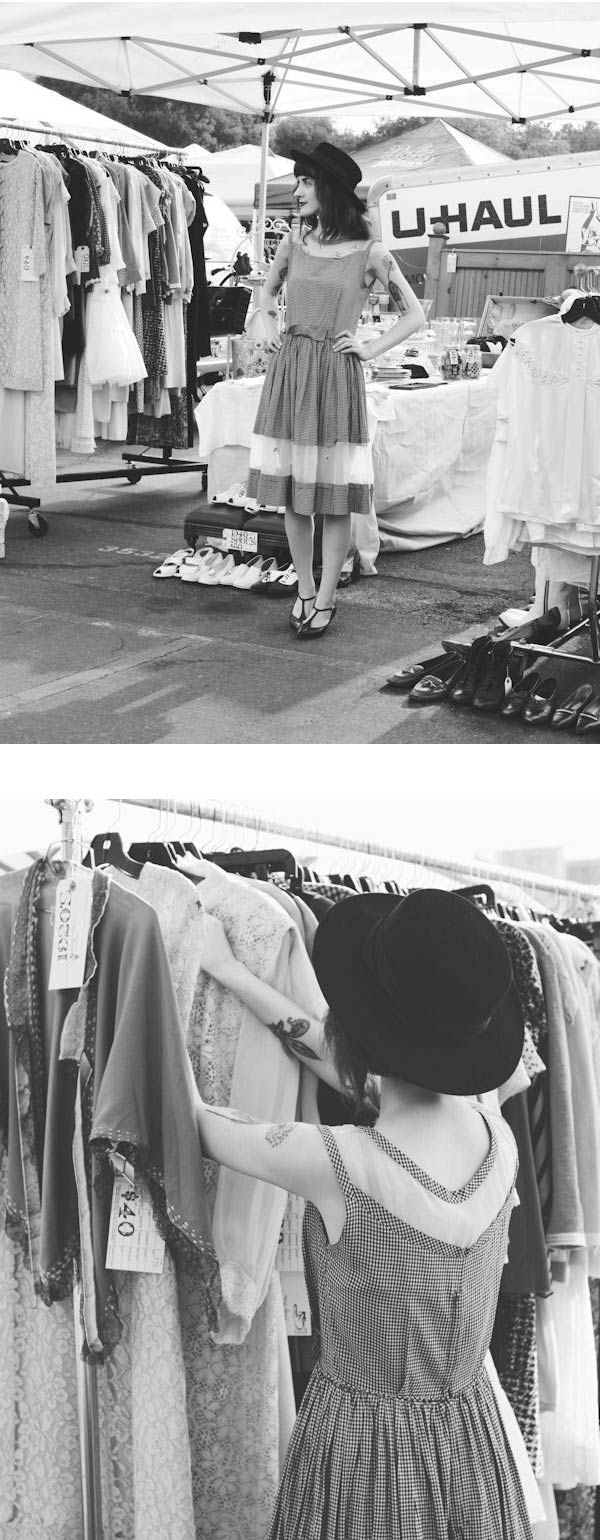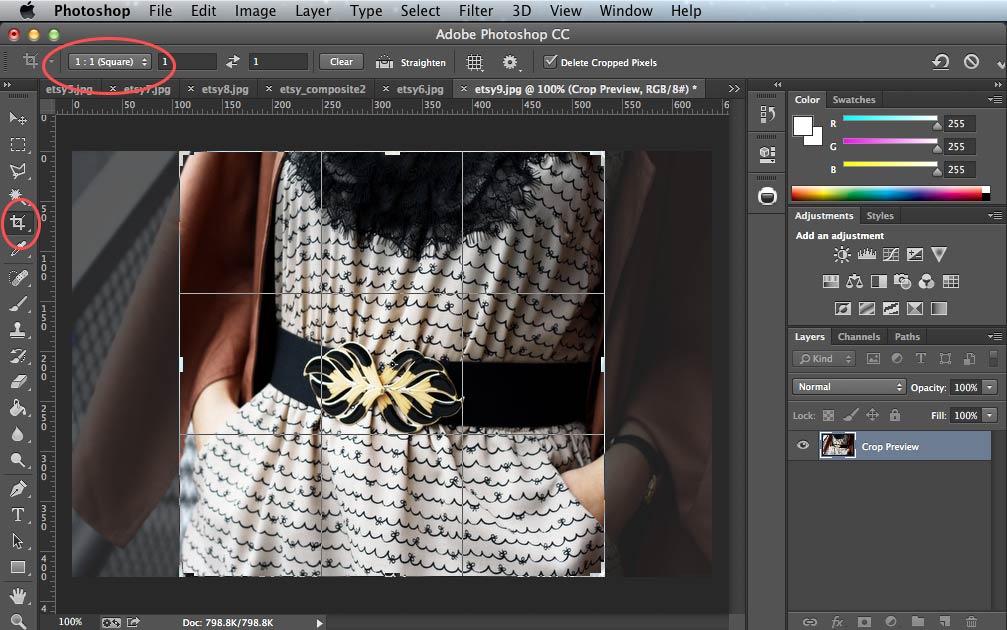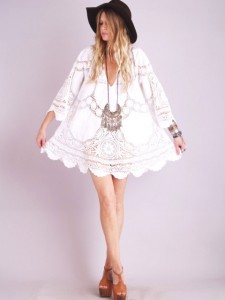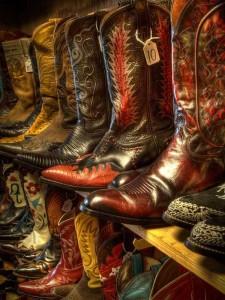Trove
Vintage Fashion for the Modern Girl

Kiana McCourt, Finch & Fawn Etsy Shop Owner
Selling: It’s Time to Amp Up Your Etsy Shop!
Learn how to delight your customers and increase your sales
*Sponsored Content
November 9, 2013
A friend and I recently had to get last-minute party dresses for an event. We’d heard about a hidden vintage dress shop in Manhattan. As we walked down the street I was told it was on, I looked at the buildings and something red and flowy caught my eye—a gorgeous lace and tulle dress was hanging from a fire escape across the street. “That’s it!” I shouted and grabbed her hand. We were buzzed into the building, and up a flight of stairs we found a magical land of perfectly curated dresses of vintage polyester, lace, tulle, linen, sequins and leather.
Now, why am I describing a hidden boutique in New York City? Because I realized, as I flipped through the racks of floral, leopard and gingham prints, that this shop gave me the same thrill as a Sunday afternoon spent surfing “rockabilly dress” in Etsy’s Vintage Category. Etsy Vintage still feels like a bit of a secret, but it’s one of its fastest growing Categories, so I’m sure it won’t feel that way for long. I wanted to gather tips from those Etsy vintage sellers who have really rocked the Category with their amazing finds, perfect photos and outstanding customer service. These sellers are what has inspired the growing buzz around vintage on Etsy. Selling vintage goods and antiques on Etsy is definitely a learned art, so follow these tips to really amp up your shop!
Curation Tips
First thing’s first, you need pieces to sell. Etsy considers anything 20 years or older “vintage,” so that’s your first guideline. (Learn more about what you can sell on Etsy.) However, sellers like empressjade warn, “Be selective in what you sell: Just because it’s old doesn’t mean anyone wants to buy it! Items should be carefully selected for desirability, style, and condition, or you are going to lose money.”
Thrift stores, flea markets, garage sales and your great aunt’s closet are a few go-to places to find treasures for your Etsy shop. When you’re digging through these spots, TheHopeTree says, “Shop, buy and list from your heart. Sometimes we don’t want to list something that is too quirky, old, or strange, but if you like it, someone else might, too.”
So have fun, but try to also do your homework. “As a seller of vintage, it’s crucial that you know what you are selling. Spend time researching, buy a lot of books, and perhaps focus on one era or type of item and learn all you can about it. It seems simple and so many people think they can hit a couple garage sales and kapow, they’re a vintage dealer, but it doesn’t work that way. Dealers know a lot about what they are selling and usually know a lot about items that they don’t sell. It’s a great job for people who really enjoy reading, learning and researching history and trends,” suggests AustinModern.
Almost every other tip mentioned doing research. MilliesAttic couldn’t insist enough, “Research, research, research… It does take time to find the information, but it’s a must if you are selling or buying vintage.” DemolitionDaughters added, “Keep up with current trends, too. It keeps you in touch with which items have particular appeal.”
Get creative. StorkVintage says, “Selling items in groups of two, three and four is a wonderful idea and gives your buyer a head start on their own collection!”
When I’m critiquing a shop with handmade items I’ll often suggest that the artist find a unique point of view, especially if they’re working in many different mediums. As such, I thought it was interesting to hear Sommersbreezeantique say, “Pick a theme or an era of vintage that you want to sell. It is easier to focus, learn and buy if you stick to a particular time period. Find a time frame of years that you like: perhaps the Art Deco era? Maybe retro 1950s or 1800s primitives? Find a time frame that you like and purchase only that time line of antiques. You will catch on quickly as to what your items will sell for.”
Pay careful attention to items at the ends of racks. This is where other savvy ragpickers have likely left the pieces from their haul that they ultimately decided against. Keep in mind that most thrifters are shopping for themselves and therefore often cast off otherwise amazing pieces because of fit. As a dealer, you’re not limited by your girth.”—From Huzzah’s Guide to Thrifting For Success
Photography
You have your first batch of collectibles and you’re ready to rock your Etsy shop. The next step is to take top notch photos. Our blog has a few dozen photography how-to’s, from finding the right camera to tips on brightening your photos. I would suggest starting with Photographing for Success.
However, there are a few tips that are specific to selling vintage. FunRetro suggests, “Shoot from every angle. People have said very positive things about my photos because I keep them crisp and shoot from all sides. No one wants to have to deal with a return because you neglected to include a photo of that rusty spot or missing button.”
Metroretrovintage adds, “Show more than just the ‘front’ (in your photos), since backs, bottoms, insides, and other hidden areas provide significant date clues. These date clues are important to knowledgeable vintage buyers who wish to make an informed purchasing decision.”
OhFaro agrees, “Always offer a picture of the maker’s mark, no matter how small, as they help sell an item. Even if you don’t know what the maker’s mark or hallmarks mean, show them, because the buyer/collector probably will.”
Real life models are always a great way to pull a buyer into your shop. “I get a lot of comments from buyers who like seeing real people in my pictures. My plus size buyers love that my plus sized clothes are on plus size girls,” says greatgrandmaagnes.
When you do start making consistent sales try to reinvest some of your profit into your business. Perhaps you could use a new camera? “I used some of my earnings to purchase a clothes steamer, which has proven to be a great time-saving tool when preparing my clothing for photos. The old cliché that ‘time is money’ is true. Use your money to save yourself time and make yourself more money!” says PineappleMint.
Here is my number one tip that I wish I’d known early about photos: Etsy crops pictures almost square for thumbnails, using the middle of the pictures as the center. This means that long, rectangular pictures are going to lose their head and feet. Hence all the thumbnails on Etsy are essentially columns of clothing against a background, cropped at top and bottom. To fix that, just use Picnik or Photoshop to crop your picture to a square yourself. Then the whole thing will just shrink down for the thumbnail. Genius, no?

Using the Square Ratio in the Crop Tool in Photoshop
Promoting and Marketing
“As far as marketing, I personally find blogging to be a good method. It allows buyers to see that you do have knowledge in your field and inspires trust and confidence in what they’re buying. Most buyers need to trust that what they are buying is authentic and from a dealer that knows their stuff, so having a blog that shows that aspect will help,” says Blythehopesvintage.
Create buzz by letting your customers in on your treasure hunts. GingersGirl states, “I take my camera along with me to estate sales, junk heaps, resale shops… I take my readers on the hunt with me. When I get new stuff, they are the first to see it. Most of the time they see it while it is still in the back of my car or before I have cleaned it up, several days before I list it in my shop!”

Excellent Etsy product photos from Finch & Fawn
“Staying relevant and informed means participating in discussions on Etsy and other sites such as The Vintage Village."

Photographing items on models with styling suggestions is a great way to interest buyers
Customer Service
HappySteller has two customer service tips: “Go the extra mile for your customers. I seek out finds I know certain customers collect, and in a very short time I’ve built a very loyal customer base.” She also reminds sellers to fill up their shops: “Customers want more than a few items to choose from.”
Archivia says, “One great way to remove smoke and other odors from vintage items is to seal them in a plastic bag filled with kitty litter or newspaper and/or baking soda, all of which absorb the odors out of the item within a few days. For tougher odors it sometimes takes two treatments.”
Many vintage sellers have taken a vintage pledge of honor. VintageEmbellishment explains, “Several of the sellers on Etsy have posted this in their shop announcements: ‘______________ has taken The Honest Vintage Pledge: Everything that I have tagged as vintage in my shop is at least twenty years old or older. I stake my reputation on it. I will never knowingly sell a fake or a repro knockoff to my customers. EVER.’” I love this idea!
Community
The Etsy Forums and Etsy Teams program can give you a lift when you need it. LuckyMeLuckyYou says, “Get involved in the Forums. There’s a great thread with vintage sellers called ‘We Love Vintage! Do You?‘. I have met a lot of cool people and learned a lot from them.”
HighDesertRose gets more than just friendship from the Etsy community. “Staying relevant/competitive and informed means participating in discussions on Etsy and other sites such as The Vintage Village. These resources are priceless. Friends are made, relationships/networks built.”
ThreeChicksVIntage agrees, “Network by getting involved in at least one good vintage Team. You can learn a lot from others ‘in the business’ and have a lot to share.”
There’s a great network of vintage Etsy sellers off Etsy, too. FunRetro suggests getting involved with the blogging community. She says, “Create a blog to share what you’ve learned, spotlight cool items from sellers, add links to key research sites, or just to talk about your experience. There is a whole universe of people out there just like us and blogging is a great way to meet them!”
GingersGirl believes in good karma. “I would also say to help each other out if you can! I had a customer who wanted more of a certain item. I was looking for it, believe me, and just COULD NOT find more. One night in the Forums I saw a vintage shop with that item and passed the link on to my customer.”
Titles & Descriptions
After great photos, titles and descriptions are the next important areas in your shop. (They also can be the hardest areas to master.) Be sure to read about how to increase your listings’ relevancy ranking in Etsy search. A few tips from Wire9Vintage: “Describe the colors, the fabric, the shape, where the hem falls on an average person, the shape of the item, and most thoroughly describe the condition (show damage clearly in photos, too). Monitors show things differently, so it doesn’t hurt to describe carefully in addition to photos. Shoppers will buy things with a little damage (sometimes a lot of damage!). But they have to be able to make an informed decision.”
“Good rule to follow about both descriptions and condition: explain it the way you would explain it to your mother. Your mom’s a smart lady, but maybe she isn’t as into vintage stuff as you are and doesn’t live for the next antiques show that comes to town. She doesn’t know the lingo or any of the stuff that you totally take for granted (then again, my mom was a dealer and taught me tons, but you get what I mean). Just keep it simple but thorough, and show as much as possible in your images. Your buyers will trust you for this, and hopefully return often,” adds MyHanaleiHome.
EarthElements has a great tip to help with titles: “Think like a buyer who is out there in cyberspace looking for just the item you are trying to sell. And then work on titling it as you might expect them to search for it.”
Don’t forget that buyers come from search engines like Google, too. 4GetMeNotTreasures says, “Describe the ever important maker of the item. I’ve found that putting this tidbit of info in the title as well as the first line of the description really helps to bring traffic from the search engines to my shop.”
Do you sell vintage clothing? SassySisterVintage suggests, “Be aware that the sizing on vintage clothing isn’t the same sizing that we have today. For instance, a piece of vintage clothing from the ’60s that is listed as a size 10 is actually around a size 3 to 5 by today’s standards.” Tlgentile adds, “As a vintage clothing buyer, I want measurements, measurements, measurements — top to bottom. Vintage clothes are sized so differently that it’s important for me to make sure what I’m getting is going to fit!”
Etsy is a global marketplace, so be sensitive to the needs of international buyers. Coconutroad says, “I measure everything in inches/feet and in centimeters/millimeters. This will encourage buyers from other countries. Measuring the item gives a more complete view of it.”
I love this creative tip from ShinyGoLucky: “Include a description of how the wonderful vintage find can fit into their modern life. ‘This pearl collar will be stunning when paired with your little black dress or worn to a Mother’s Day brunch.’”
Pricing
Our blog also has a series of pricing articles, called The Art of Pricing, to get you started. Researching competitors is somewhat important when selling handmade items, but especially important when pricing antiques and vintage. Waalaa says, “Pricing an item is almost entirely subjective. Research similar items for a better idea of how to price your own item.”
“If something’s not selling after a month, it’s probably time to lower the price. Sometimes when we don’t know what to charge for something, we search eBay. If it’s selling on eBay for $5.00, we know we can’t try to list it for $30.00.”—From Starting an Etsy Business: White Elephant Vintage
Tagging
Each item listing comes with tags to describe your items. Use search terms that buyers might look for.
Make sure you include the era in your tags. You might want to use three tags: “60s,” “1960s,” and “sixties.” But don’t fill up your tags with only era-specific information. PennyDreadfulVintage says, “I also think it is really important to keep in mind other factors such as colour, size, fabric, cut and style — often when I am shopping for vintage I am looking for a certain TYPE of item, I don’t really care about the era. For instance, at the moment I am obsessed with finding a perfect buttercup yellow lace mini dress for summer. I really don’t care what era it is from, so all those other details are really important for my search.”





Comments are closed.